Growing seedlings is fun, but keeping them alive can be challenging. In this detailed seedling care guide, I will show you everything you need to know about how to grow healthy starts for your garden.
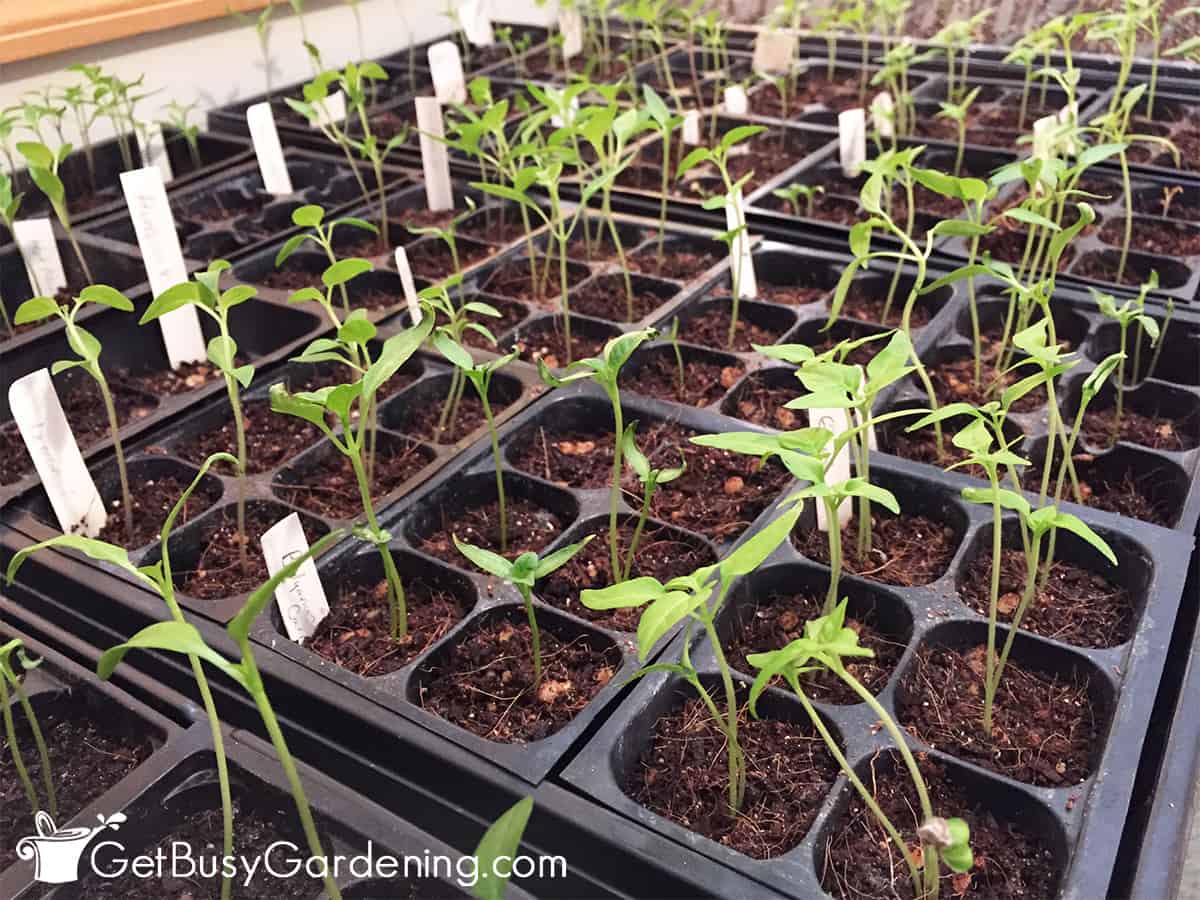
Getting your seeds to germinate is one thing, but figuring out what to do with seedlings once they start to grow? Well, that’s a whole different ballgame.
But, once you learn all about proper seedling care, you can easily keep them thriving. Plus you’ll feel confident that they’ll be strong enough to survive the transition to the garden.
In this guide, I will teach you everything you need to know about growing seedlings. If you want to start from the beginning, then get my best tips for how to grow seeds indoors here.
Growing Seedlings Indoors
I love growing my own seeds! No matter how many times I do it, I always get super excited when I see the first signs of life in my trays. It’s so much fun!
But after the elation of seeing your first sprouts popping out of the dirt wears off, reality sets in and you might suddenly wonder… Oh crap, my seedlings are growing! NOW what do I do?!? (gulp)
Don’t panic, I’ve got you covered. Keep reading and I’ll show you exactly what to do with seedlings after they start to germinate.
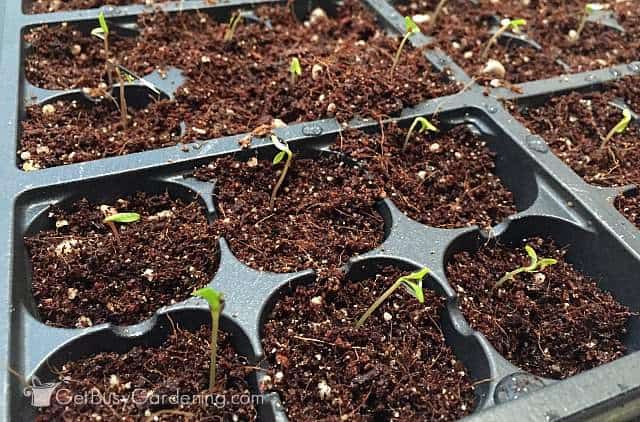
Seedling Care Instructions
Growing seedlings doesn’t have to be a huge struggle! With the proper care, they will not only survive but they will thrive in your garden.
Follow these instructions for taking care of seedlings after germination…
Light For Seedlings
Light is one of the most important factors of seedling care, and that’s why I’ve listed it first. Some will grow OK sitting next to a sunny window, but most will require more light than that.
You can learn more about proper lighting for seedlings here, but I’ve listed some quick tips for you below.
- When to start using lights – You should turn the grow lights on as soon as you see the first specks of green popping out of the dirt.
- Types of lights – There are tons of options here. You can buy a full-blown system, or just get the grow lights.
- Amount of light – Ideally, the grow lights should hang 3-4 inches above the seedlings at all times, and be kept on for 12-14 hours a day (an inexpensive outlet timer really comes in handy for this!).
Related Post: How To Make Easy DIY Grow Lights For Seedlings
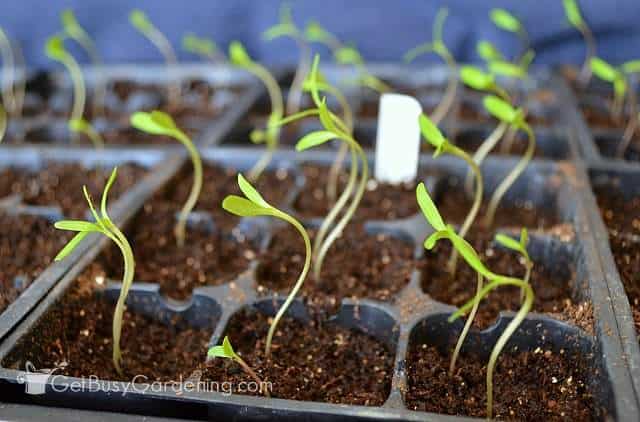
Proper Seedling Watering
Proper watering is another extremely important part of successful seedling care. Seedlings need consistently moist soil. They can’t survive long without water, and should never be allowed to dry out completely.
However, never allow the soil to be wet all the time either. Soggy soil promotes pest infestations, mold growth in trays, and diseases that can kill your seedlings, like damping off.
Plus, too much water will ultimately kill them, and you don’t want that. Here are some tips to get it right…
- How often to water – You should check on your seedling trays a few times a day to see how moist the soil is. Once the top layer of soil starts to dry out, then it’s time to water. They will need to be watered more often as they grow larger.
- How to water – The best way to water is by pouring it into the tray, and then allowing the soil to absorb it through the drainage holes. Bottom watering will help ensure the roots get plenty of moisture, and avoid disturbing or displacing the delicate seedlings. Be sure to dump out any that’s not absorbed after 30 minutes.
- How much to water – Fill the tray just enough to cover the holes in the bottom of the cells so they can absorb it.
An inexpensive soil moisture gauge is a wonderful tool that will help you give your seedlings the perfect amount of water. I highly recommend getting one.
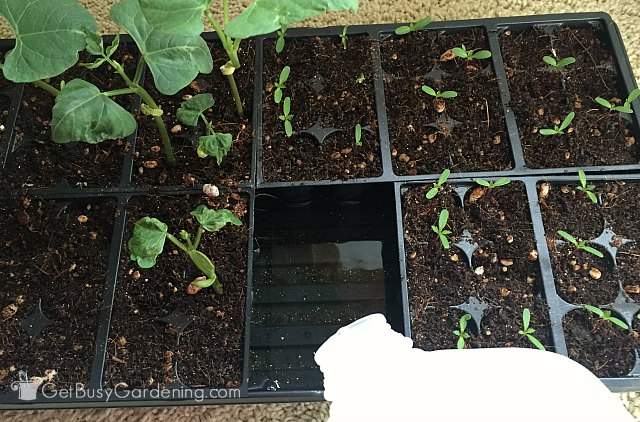
Seedling Ventilation & Airflow
A common question I get from newbies is when to remove the humidity dome for seedlings. Great question!
It’s time to remove the dome lid once most of the seedlings in the tray have started to grow. But it’s best to do this slowly by ventilating the lid, rather than just removing it.
Start by propping it open an inch. Then keep propping it another inch or so every few days until the lid is completely off. Once the humidity dome is off, you can leave it off.
Airflow is also important for growing seedlings and preventing some common problems (like mold and overwatering).
Once the lid is off, I like to use an oscillating fan to provide additional ventilation, and help to strengthen them.
I keep my fan plugged into the same outlet timer as my grow lights. I set it on low so it rotates and gently blows over the seedlings all day long, then it automatically turns off at night.
Keep in mind that the soil can dry out very quickly after you remove the lid, especially if you use a fan, so you should check the moisture level more often.
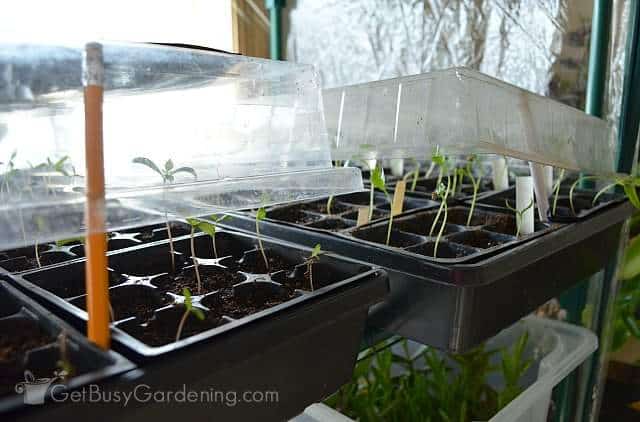
Thinning Overcrowded Seedlings
If there’s more than one seedling growing per cell, then you will need to thin them. It is really hard for some people to do this, but it’s very important.
Below are a few tips to get you started, but you can learn how to thin seedlings step-by-step here.
- Why do seedlings need to be thinned? – Because otherwise they will start to compete with each other for light, water and nutrients. It’s also really difficult to give seedlings proper airflow when they’re overcrowded.
- How big should seedlings be before thinning? – You can start once your seedlings have a few sets of their true leaves. Snip out the weakest so that only the strongest one is left growing in each cell.
- How to pick the strongest seedling – Keep the one that looks the healthiest and is the most compact, and pinch or snip out the leggy or weak looking seedlings. If they all look the same, then just choose one of them to keep per cell.
Fertilizing Your Seedlings
Once you start to see true leaves, it’s time to begin fertilizing them as part of a regular seedling care routine. But you don’t want to feed them a full dose of fertilizer, because they are just babies. Follow these tips…
- How to fertilize seedlings – Start feeding them with a weak dose of liquid fertilizer at first (about 1/4 of the regular dose). Then slowly increase the strength of the dose as they grow larger.
- The best fertilizer for seedlings – I recommend using natural, organic fertilizers rather than synthetic chemicals. Chemicals are notorious for burning seedlings, and they don’t work as well as organic types do.
I use (and highly recommend) an organic compost solution (you could also buy tea bags to brew your own) on all of my indoor seedlings.
Liquid kelp and fish emulsion are also wonderful, and seedlings absolutely love them… but beware that these can get a bit stinky when used indoors.
Transitioning Mature Seedlings
Once your seedlings grow larger, it’s time to start thinking about transitioning them to the next phase. Most will do best when they’re put into larger pots, rather than left growing in the small starter cells.
That will give them plenty of room to grow larger before it’s time to move them outside and into the garden.
Related Post: How To Harvest & Collect Seeds From Your Garden
When To Move Seedlings To Pots
The general rule is that, once the seedlings have grown to be about twice as tall as the height of the tray, then they should be put into bigger pots. Learn all about repotting seedlings here.
Most can handle staying in the small containers for a few weeks, as long as you keep them watered.
But, if it’s going to be more than a week or two before you’re able to plant them into the garden, you should pot them up.
Plantable pots are a great option, and they make planting seedlings into the ground later on super easy.
Peat pots are popular and fairly inexpensive, I recommend buying either the 3″ size peat pots or 4″ peat pots for seedlings.
If you’re worried about the sustainability of peat, then get some that are made out of coco coir. You can use a 2.25″ size, or a 3″ size pot for seedlings. Heck, you can even buy pots made out of cow manure! Wow!
Of course you can always put them into reusable plastic pots if you have them on hand, to save yourself some cash.
Preparing Seedlings For Planting Outside
Hardening off is a crucial seedling care step that many newbies miss. But, if you planted your seedlings from your house directly into the garden, they would probably wither and die (eek!).
Seedlings growing indoors need time to get used to being outside before they are planted into the garden. So never skip this step!
Once the weather warms in the spring (above 50 degrees F), put your seedlings outside in a shady location for several hours each day. They should be protected from sun, wind and heavy rain.
Gradually expose them to the sun over several days. Keep in mind that the soil will dry out much faster outside, and the seedlings may need to be watered more than once a day, so check on them regularly.
When the weather is warm enough, they can be left outside overnight. Learn exactly how to harden off seedlings step-by-step here.
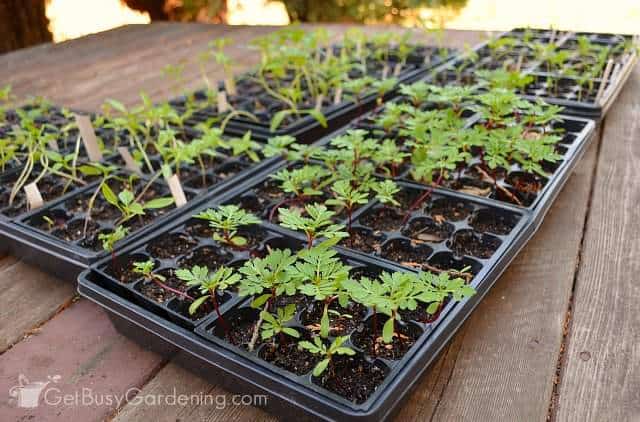
When To Plant Seedlings Into Your Garden
Ok, so you’ve got these seedling care steps figured out, and you’ve managed to keep your babies alive. That’s awesome! Now you’re probably wondering when you should put them into the ground.
Cold weather plants like broccoli, cauliflower, carrots, radish, parsley, leafy greens (like lettuce) and others that can handle light frost can be planted as early as 2-4 weeks before your average last frost date.
Warm weather seedlings like tomatoes, cucumbers, basil, beans, squash and peppers shouldn’t be planted into the garden until after all chance of frost is gone.
If you don’t know your average last frost date, check with a local garden center. Get more details about how to figure out when to transplant seedlings into the garden here.
Troubleshooting Common Seedling Care Problems
Once you get the hang of it, you’ll find that it isn’t all that hard to grow seedlings. But it can be extremely frustrating when they start having problems, and you don’t know why.
So to help you figure it out, here are a few of the most common seedling care issues, and their causes…
Leggy Seedlings
This is the biggest problem with growing seedlings indoors, and it happens when they don’t get enough light.
Add a grow light, and hang it right over the top of the seedlings. Then leave it turned on for 12-14 hours a day.
Seedlings Leaning Over, Stretching, Or Growing Sideways
Inadequate light is the main cause, but it can also happen if the lights aren’t positioned properly.
If you’re trying to grow seedlings in a window, then add a plant light. If you already have a light, then move it so that it is directly above the seedlings at all times.
Seedlings Dying After Sprouting
If your seedlings died shortly after they started growing, then it was likely because of seedling blight.
This is a disease that causes something called “damping off”, which kills seedlings at the base. The only way to prevent this is to disinfect your seed trays before using them again.
Yellow Seedlings
The main cause is overwatering. Be sure that the soil is never soggy, and allow the very top to dry out a bit between waterings.
Small Seedlings, Or They’re Not Growing
Seedling growth can be stunted when it’s too cold in the room, if they are over or under watered, or if they aren’t getting enough fertilizer.
Get even more help with troubleshooting and fixing seedling problems here.
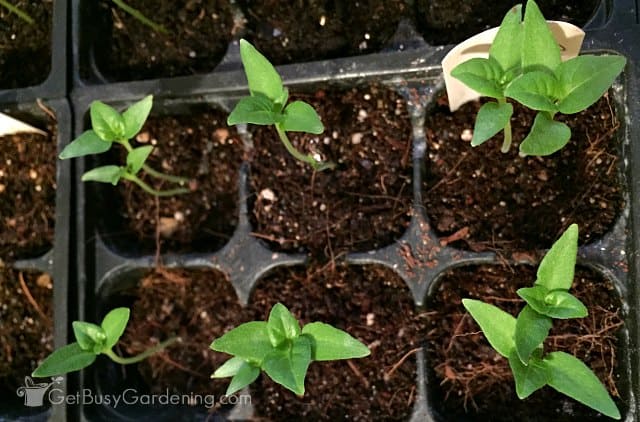
Seedling Care FAQs
In this section, I will answer the most commonly asked questions about growing seedlings. If after reading this guide and these FAQs you still can’t find the answer to your question, then ask it in the comments below.
What are true leaves?
The term “true leaves” refers to any of the ones that grow after the first two leaves. They look like tiny versions of the leaves on a mature plant.
How long does it take for seedlings to grow true leaves?
That depends on the type of seedling. Some will start growing true leaves within a few days of germination, others can take several weeks.
It’s best to check the seed packet, or research the type of seedling you’re growing for specific timing.
How do you make your seedlings grow faster?
Heat, light, and fertilizer are three ways to improve seedling vigor, and make them grow faster.
If yours aren’t growing, then check the temperature of the room first. If it’s below 65 degrees F, then try keeping seedlings warm using a space heater or a heat mat.
Also be sure you’re providing adequate light and fertilizer to help speed up the growth. See the”Light For Seedlings” and “Fertilizing Your Seedlings” sections above for more details.
When should I water my seedlings?
Water your seedlings when the tray is empty, and the top of the soil is starting to dry out. Never allow the soil to dry completely though. Read the “Proper Seedling Watering” above for more details.
How do you grow strong seedlings?
All of the factors in this guide are important for growing strong seedlings. But adequate lighting and proper watering are by far the most important to help them thrive.
Can seedlings get too much light?
Yes. If you leave the lights on 24 hours a day, it can confuse them, and cause problems later on when you move them outside.
It’s best to simulate the natural sunlight pattern, and allow them a period of darkness each day.
How many hours of light do seedlings need?
Giving your seedlings 12-14 hours of light a day is ideal, and using an outlet timer makes it a snap.
When should I start seedlings?
It depends on the type of seeds. Follow the instructions on the seed packet to determine when to plant them. You can learn all about when to start seeds indoors here.
Where Can I Buy Seedlings?
You can find seedlings for sale at your local garden center in the spring and summer. Be sure to shop early for the best selection though, cause they can sell out fast.
Learning what to do after they start growing, and keeping them alive and healthy is tricky. But if you follow the seedling care tips above, it will be a snap! Not only will they survive the transition into the garden, but they will also thrive all summer long!
Looking for more more help growing any type of seed you want? Then you should take my online Seed Starting Course. It’s a fun, comprehensive, and self-paced online course that will show you exactly how to easily grow strong, healthy seedlings for your garden. Enroll and get started now!
Otherwise, if you just need some tips for growing seeds inside, then my Starting Seeds Indoors eBook would be perfect for you! It’s a quick-start guide to planting seeds indoors for beginners.
Find even more useful and essential seed starting supplies & equipment I recommend here.
Leave a comment below and share your seedling care and growing tips.
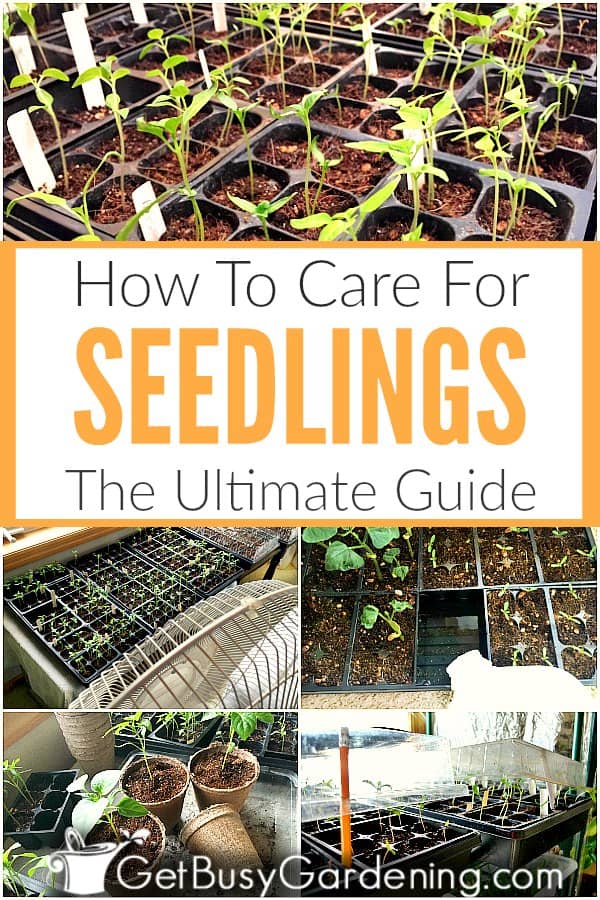
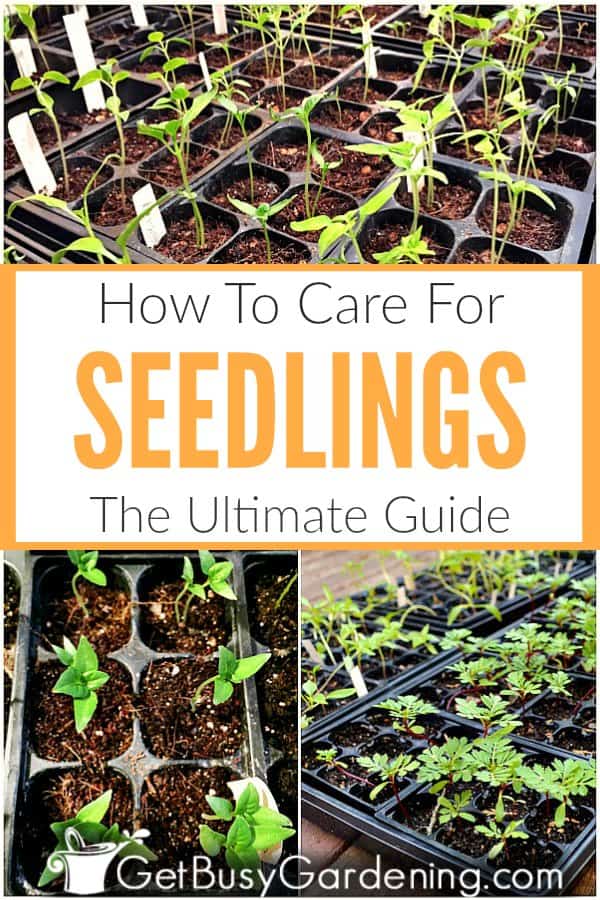
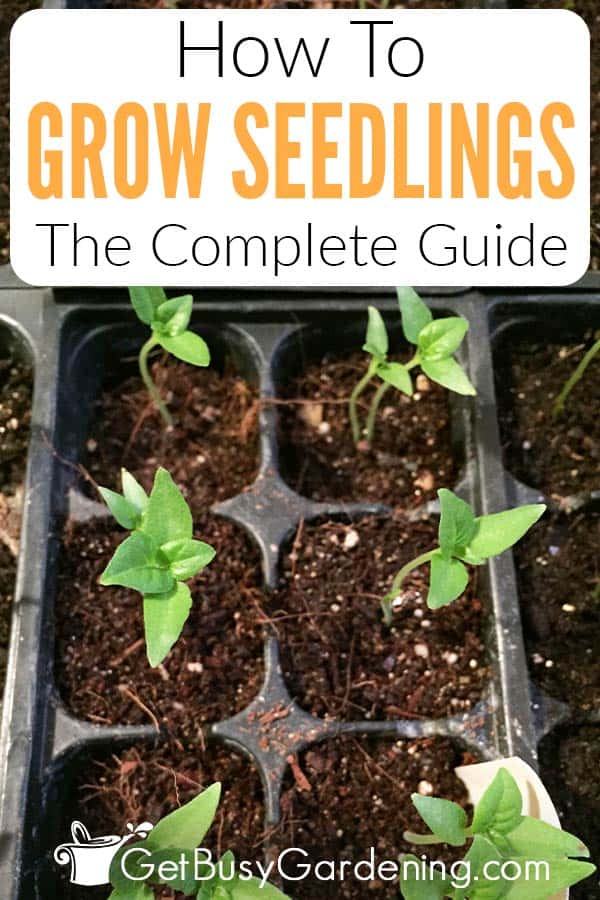
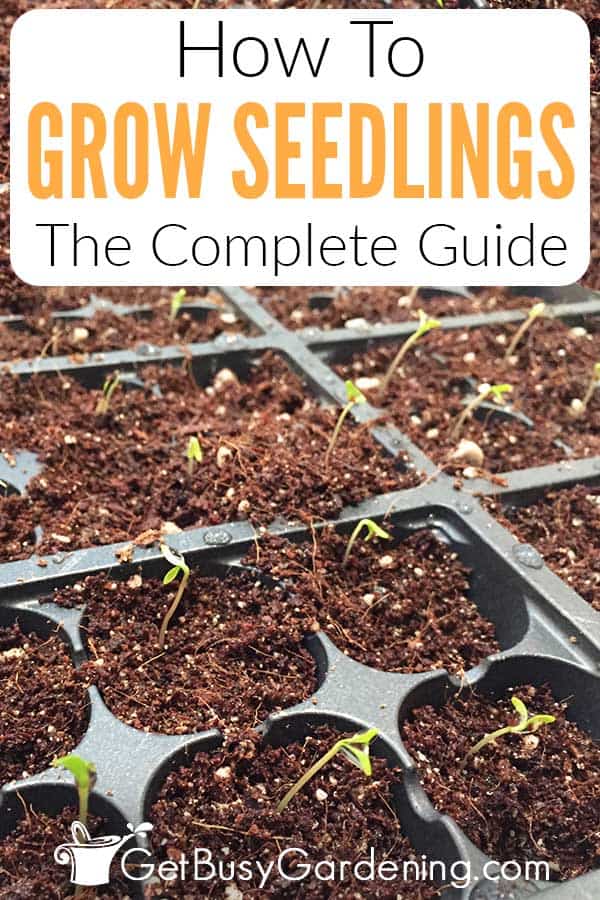
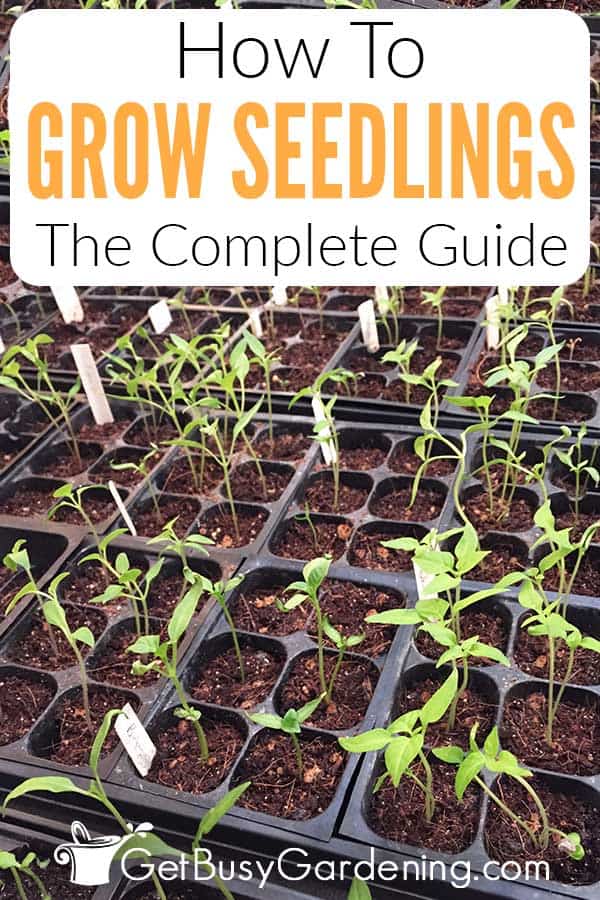


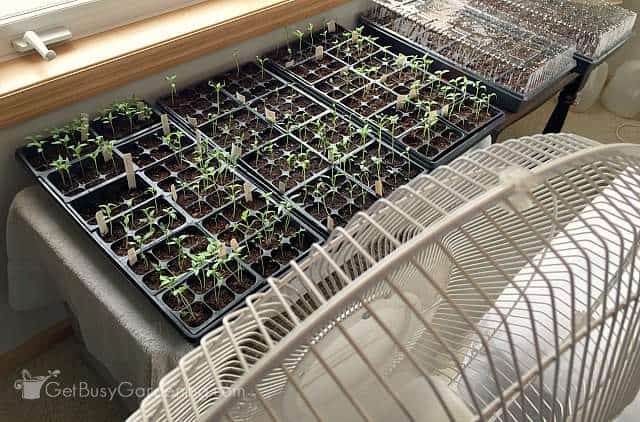
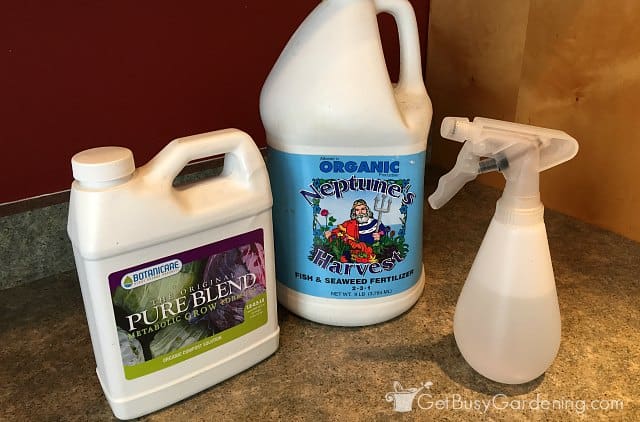

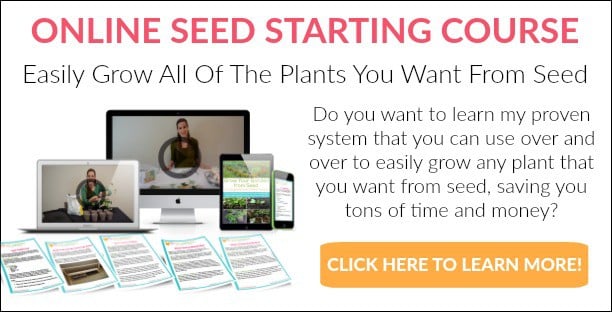

Ricci says
Thanks for the info ,
I’ve having a terrible time with something eating off the leaves of the seedlings , doesn’t seem to be mice and I’ve totally cleaned out my greenhouse and disinfected it so I’m pretty sure I’ve killed any insects But still when I put out the seedlings back into the greenhouse they end up with just a stem overnight .. got any ideas/suggestions
Amy Andrychowicz says
It sounds like you may have slugs or maybe some type of caterpillar hiding in your seed trays/soil. Go out there at night with a flashlight to see if you can find anything, and look for slime trails (a telltale sign of slugs).
Gerry Fisher says
My seedlings are popping up nicely, I live in Virginia Beach and am wondering when I should start setting them outside to adapt them so I can plant them outside
Amy Andrychowicz says
Awesome, I’m so happy to hear your seedlings are doing well! You can start hardening them off about 7-10 days before you plan to transplant them into the garden, but wait until the daytime temperatures are consistently above 60°F. Here are my instructions for exactly when and how to harden off seedlings. Good luck!
Edwin Stephens says
Good article. However, I have a question. Is this article mainly geared toward vegetable and fruit gardening, or does it also apply to flowers? I want to start some native flowers from seeds, but I can’t seem to find all the information I need. Almost all the articles I read talk about fruits and vegetables.
Any information would be appreciated.
Amy Andrychowicz says
This article applies to growing ANY type of seedlings.
Collin says
Hello! Thank you for all of this amazing information! It has been super helpful. I got a moisture meter, but I don’t know what level the seedling should be at. Do you have any recommended target for moisture level?
Amy Andrychowicz says
You’re welcome! For seedlings you want to maintain the moisture gauge in the green area, so between 4-7.
Mary Anne Watt says
My seedlings are under grow lights right now. My Snap dragons have lost their tops! A few of mystocks have little nibbles on the edges of the leaves.
What could be doing this?
Thank you in advance for your help.
Amy Andrychowicz says
How weird! It sounds to me like you somehow have a critter hiding in your flats, and it’s eating your seedlings. My guess is either some kind of tiny caterpillar, but it could be a baby slug (if it were full-sized, your seedlings would have been gone in one day, LOL!). Inspect the leaves very closely to see if you can find the culprit. They are teeny tiny when they’re babies, and can be very hard to see. Slugs only come out at night, so wait until after dark and check for them with a flashlight. Good luck!
Nikki says
Hello I am trying to grow Asian greens but they seem to be always leggy seedlings. I start indoors as it’s quite hot here in swq . I put them in sun in mornings and then after true leaves come plant out side under shade cloth . If I am doing something wrong your advise would be greatly appreciated.
Amy Andrychowicz says
It’s difficult to care for bean seedings indoors because they need a lot of light, and they grow very fast. A sunny window won’t be enough to keep them from getting leggy. So, for bet results, you’ll either need to add a grow light indoors and leave them on for 12-14 hours/day, plant the seeds outside in a pot or other container, or direct sow them in your garden.
Deb schaefer says
Hi! I am a gardener from forever but this year decided to go that step further and start my own plants. What an adventure! My guy is also an avid hippie gardener and we love to do things our own way in the gardens. No rules just joy! All of your information is just exactly what I was looking for. One question though, I have heard that topping the tomatoes and peppers will make for a sturdier and fuller plant. True or not true, and how is this done if it is true?? Thank you for your great advice! Happy playing in the dirt and the sunshine 🌞
Amy Andrychowicz says
Wonderful to hear, you are welcome! It’s certainly not necessary to cut the tops off of your pepper or tomatoes seedlings. I’ve never done that before, and mine all do great in the garden.
Sherri Becker says
Hi – Thank you for all the information you provide! I’m also from MN and this year is my first adventure of starting seedlings. Based on your writings, I transplanted a few of my plants that had grown to be too tall for the dome into larger pots. I’m concerned about them. It’s only been a day but how do I know when I need to start using the fan? Is that something to do right away on those that have been potted up? I got the timers and have the lights and fan on a timer but really worried about it being too soon for the air. Any help is appreciated! Thank you
Amy Andrychowicz says
You’re welcome! Great job on growing your seedlings so far, sounds like you’re doing everything right. I start using the fan as soon as I take the lids off my flats. So, you can turn yours on anytime now. Just keep in mind that the soil will dry out a little faster with the fan blowing on your seedlings. So check on them a few times a day to make sure it’s not drying too fast. Good luck!
Angela Chambers says
Is there a point in the life of a seedling where you pinch them back? I feel like there’s a opportunity I miss between it being a seedling and becoming a bushy, healthy plant. I feel like my seedlings just become longer, leggier seedlings instead of plants like you see in nurseries. Should I sacrifice the first bud and pinch them back?
Amy Andrychowicz says
Some seedlings do better when you pinch them back. But, for the most part, no. You should not need to pinch back seedlings. If your seedlings are tall and leggy, that means they aren’t getting enough light. So add a grow light, hang it so it’s 3-4″ above them at all times, and leave it on for 12-14 hours every day.
Jan says
Hello. Thank you so much for your articles! I love the way you present all the information. I live in Mexico where it is sunny and hot most days and so started growing vegetable seeds outside. I put them directly into 3 inch biodegradable pots, thinking that this will make it easier to transplant them into bigger containers or in the garden. Is this okay? Or would you recommend that I use growing trays first? Many thanks.
Amy Andrychowicz says
You’re welcome! You certainly could plant them directly into the biodegradable pots. But I personally find it easier to use seedling trays, especially for smaller seeds. The plastic trays make it much easier to maintain the proper moisture level for the tiny seedlings. Once the seedlings grow to be 1-2 times the height of the seed trays, then I pot them up into the biodegradable pots. Here’s more information about that… How To Repot Seedlings Into Larger Containers
Aatman Trivedi says
Great article. Very insightful! I have a few questions though:
1. When is it the right time to transplant from a bigger pot to outside? Or a bigger pot to the final pot.
2. Why is it required to give aeration slowly?
3. What happens if you are doing seedlings outside and more light is given to the seedlings but temperature is optimum. Would it catalyse the speed of the seedlings?
4. What do you suggest to do in case of dampening off?
Amy Andrychowicz says
Thank you! Here are your answers…
1. You can learn all about repotting seedlings here, and when to transplant them into your garden here.
2. Because if you do it too fast, it can shock sensitive seedlings. It’s not always necessary though.
3. Yes, heat usually helps seedlings germinate faster.
4. There’s nothing you can do to save seedlings that have already dampened off. All you can do is prevent it from happening next time by sterilizing your equipment.
Arun Shanker says
Hi, I planted Tomato seeds and it germinated well, however now they being around 4-5 inch tall the leaves are drooping and are dying off, why is this happening, the cockpit is wet and also I am daily adding nutrients to the same too?
Amy Andrychowicz says
My guess is that you may be overwatering your seedlings. Keep the soil evenly moist, but never soggy or wet. They could also be root-bound, so I recommend potting them up into larger containers to give them more room to grow. Good luck!
Linda says
I would like to get my annuals to bloom in May when it is time to give some away or plant them.
Any special instructions to do that? Most of my plants usually don’t have blooms then.
Amy Andrychowicz says
Yes, lots and lots of light will be the main key to getting them to bloom indoors. I would also recommend that you start feeding your seedlings as soon as they have their first true leaves, and also pot them up once they become twice as tall as the seed starting cells. Good luck!
Linda H says
Hi Amy,
What fertilizer would you use? A high phosphorus or nitrogen?
Thanks!
Amy Andrychowicz says
Seedlings like nitrogen. Take a look at the section in the article titled “Fertilizing Your Seedlings”. There are links to the specific types of fertilizers that I recommend using on seedlings.
Casey says
I have a 20 spot germination container and a few of the seedlings are sprouting an the rest are not. What is best to do in this situation??
I don’t want to vent it too much an not have the other seedlings not sprout or start growing.
Amy Andrychowicz says
Leave the lid on your seedling tray until most (or all) of the seed have germinated.
GWENDOLYN BLACKMAN says
I appreciate the information in this article but have a question re heat mats. I purchased one and it is not warm at all. Is the heat so minimal that you don’t feel it?
Amy Andrychowicz says
I would expect your seedling heat mat should feel warm to the touch, mine does.
Michaela says
Good article! We started our seeds inside, we had nice weather then we got more snow here in Wisconsin. It kind of pushed our plans of getting the garden ready back. I don’t have a grow light, but have them covered in a plastic bag to act like a greenhouse near a window. I’ll also open the bags to let them get some sun. I have some seeds planted in the cow pots. Can I just brew some tea that I have in the house for the liquid fertilizer?
Amy Andrychowicz says
Regular tea from your pantry won’t harm your seedlings, but it won’t really help them either. Compost tea is not the same thing. It’s made from compost and/or manure, which contains tons of rich nutrients to feed the seedlings.